The AMD Radeon R9 Fury X Review: Aiming For the Top
by Ryan Smith on July 2, 2015 11:15 AM ESTCompute
Shifting gears, we have our look at compute performance. As an FP64 card, the R9 Fury X only offers the bare minimum FP64 performance for a GCN product, so we won’t see anything great here. On the other hand with a theoretical FP32 performance of 8.6 TFLOPs, AMD could really clean house on our more regular FP32 workloads.
Starting us off for our look at compute is LuxMark3.0, the latest version of the official benchmark of LuxRender 2.0. LuxRender’s GPU-accelerated rendering mode is an OpenCL based ray tracer that forms a part of the larger LuxRender suite. Ray tracing has become a stronghold for GPUs in recent years as ray tracing maps well to GPU pipelines, allowing artists to render scenes much more quickly than with CPUs alone.
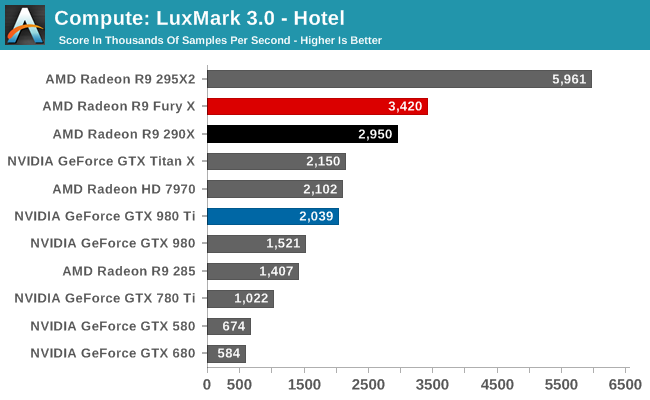
The results with LuxMark ended up being quite a bit of a surprise, and not for a good reason. Compute workloads are shader workloads, and these are workloads that should best illustrate the performance improvements of R9 Fury X over R9 290X. And yet while the R9 Fury X is the fastest single GPU AMD card, it’s only some 16% faster, a far cry from the 50%+ that it should be able to attain.
Right now I have no reason to doubt that the R9 Fury X is capable of utilizing all of its shaders. It just can’t do so very well with LuxMark. Given the fact that the R9 Fury X is first and foremost a gaming card, and OpenCL 1.x traction continues to be low, I am wondering whether we’re seeing a lack of OpenCL driver optimizations for Fiji.
For our second set of compute benchmarks we have CompuBench 1.5, the successor to CLBenchmark. CompuBench offers a wide array of different practical compute workloads, and we’ve decided to focus on face detection, optical flow modeling, and particle simulations.
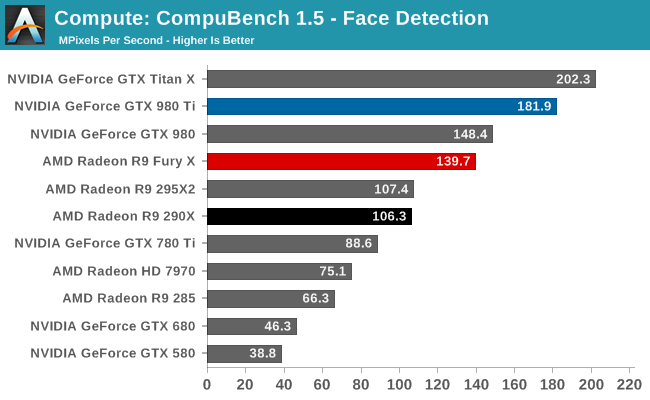
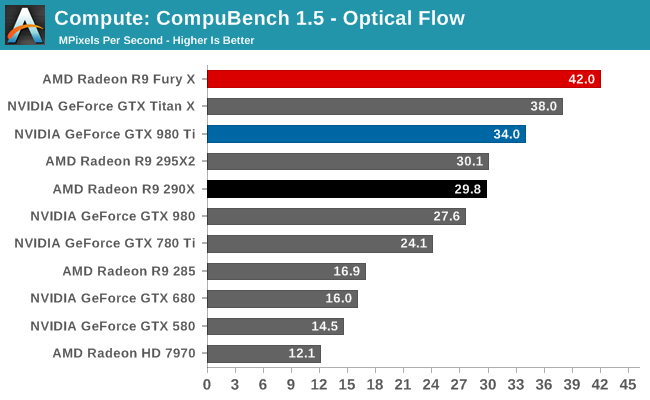

Quickly taking some of the air out of our driver theory, the R9 Fury X’s performance on CompuBench is quite a bit better, and much closer to what we’d expect given the hardware of the R9 Fury X. The Fury X only wins overall at Optical Flow, a somewhat memory-bandwidth heavy test that to no surprise favors AMD’s HBM additions, but otherwise the performance gains across all of these tests are 40-50%. Overall then the outcome over who wins is heavily test dependent, though this is nothing new.
Our 3rd compute benchmark is Sony Vegas Pro 13, an OpenGL and OpenCL video editing and authoring package. Vegas can use GPUs in a few different ways, the primary uses being to accelerate the video effects and compositing process itself, and in the video encoding step. With video encoding being increasingly offloaded to dedicated DSPs these days we’re focusing on the editing and compositing process, rendering to a low CPU overhead format (XDCAM EX). This specific test comes from Sony, and measures how long it takes to render a video.
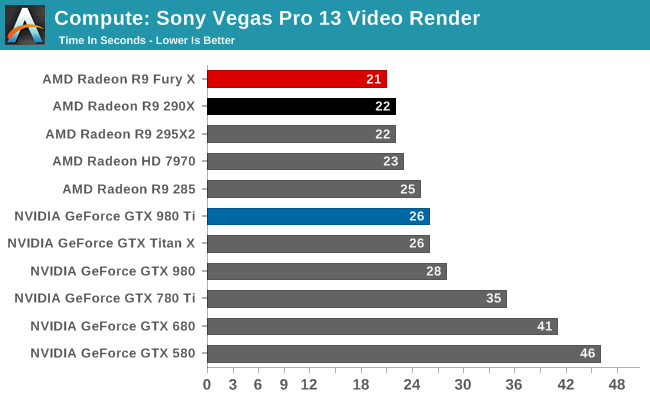
At this point Vegas is becoming increasingly CPU-bound and will be due for replacement. The Fury X none the less shaves off an additional second of rendering time, bringing it down to 21 seconds.
Moving on, our 4th compute benchmark is FAHBench, the official Folding @ Home benchmark. Folding @ Home is the popular Stanford-backed research and distributed computing initiative that has work distributed to millions of volunteer computers over the internet, each of which is responsible for a tiny slice of a protein folding simulation. FAHBench can test both single precision and double precision floating point performance, with single precision being the most useful metric for most consumer cards due to their low double precision performance. Each precision has two modes, explicit and implicit, the difference being whether water atoms are included in the simulation, which adds quite a bit of work and overhead. This is another OpenCL test, utilizing the OpenCL path for FAHCore 17.
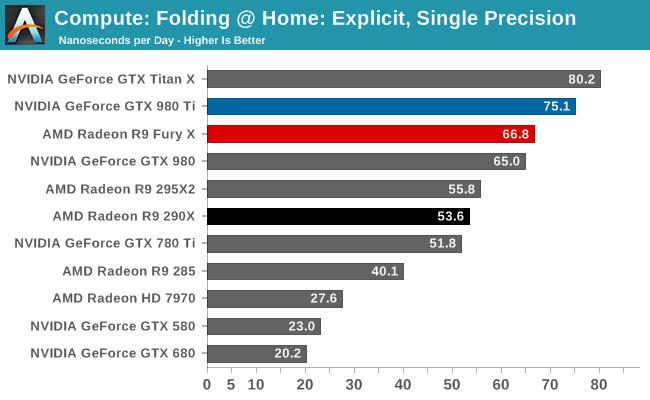

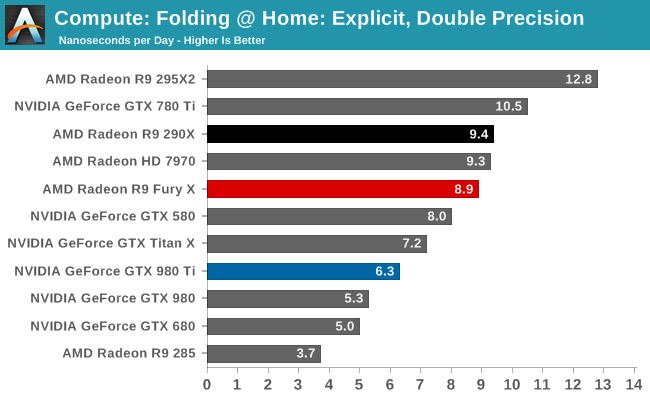
Both of the FP32 tests for FAHBench show smaller than expected performance gains given the fact that the R9 Fury X has such a significant increase in compute resources and memory bandwidth. 25% and 34% respectively are still decent gains, but they’re smaller gains than anything we saw on CompuBench. This does lend a bit more support to our theory about driver optimizations, though FAHBench has not always scaled well with compute resources to begin with.
Meanwhile FP64 performance dives as expected. With a 1/16 rate it’s not nearly as bad as the GTX 900 series, but even the Radeon HD 7970 is beating the R9 Fury X here.
Wrapping things up, our final compute benchmark is an in-house project developed by our very own Dr. Ian Cutress. SystemCompute is our first C++ AMP benchmark, utilizing Microsoft’s simple C++ extensions to allow the easy use of GPU computing in C++ programs. SystemCompute in turn is a collection of benchmarks for several different fundamental compute algorithms, with the final score represented in points. DirectCompute is the compute backend for C++ AMP on Windows, so this forms our other DirectCompute test.
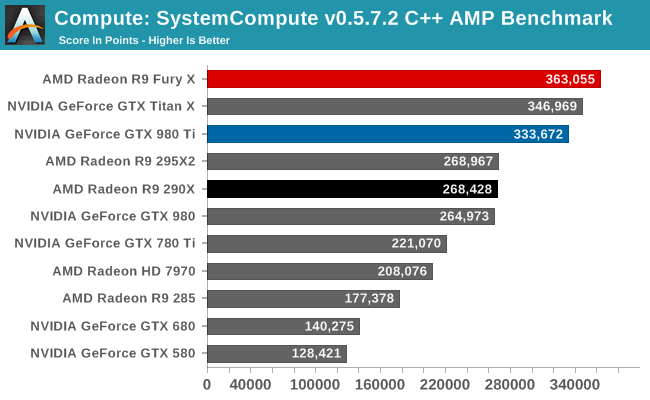
Our C++ AMP benchmark is another case of decent, though not amazing, GPU compute performance gains. The R9 Fury X picks up 35% over the R9 290X. And in fact this is enough to vault it over NVIDIA’s cards to retake the top spot here, though not by a great amount.










458 Comments
View All Comments
Samus - Saturday, July 4, 2015 - link
Being an NVidia use for 3 generations, I'm finding it hard to ignore this cards value, especially since I've invested $100 each on my last two NVidia cards (including my SLI setup) adding liquid cooling. The brackets alone are $30.Even if this card is less efficient per watt than NVidia's, the difference is negligible when considering kw/$. It's like comparing different brand of LED bulbs, some use 10-20% less energy but the overall value isn't as good because the more efficient ones cost more, don't dim, have a light buzz noise, etc.
After reading this review I find the Fury X more impressive than I otherwise would have.
Alexvrb - Sunday, July 5, 2015 - link
Yeah a lot of reviews painted doom and gloom but the watercooler has to be factored into that price. Noise and system heat removal of the closed loop cooler are really nice. I still think they should launch the vanilla Fury at $499 - if it gets close to the performance of the Fury X they'll have a decent card on their hands. To me though the one I'll be keeping an eye out for is Nano. If they can get something like 80% of the performance at roughly half the power, that would make a lot of sense for more moderately spec'd systems. Regardless of what flavor, I'll be interested to see if third parties will soon launch tools to bump the voltage up and tinker with HBM clocks.chizow - Monday, July 6, 2015 - link
Water cooling if anything has proven to be a negative so far for Fury X with all the concerns of pump whine and in the end where is the actual benefit of water cooling when it still ends up slower than 980Ti with virtually no overclocking headroom?Based on Ryan's review Fury Air we'll most likely see the downsides of leakage on TDP and its also expected to be 7/8th SP/TMU. Fury Nano also appears to be poised as a niche part that will cost as much if not more than Fury X, which is amazing because at 80-85% of Fury X it won't be any faster than the GTX 980 at 1440p and below and right in that same TDP range too. It will have the benefit of form factor but will that be enough to justify a massive premium?
Alexvrb - Monday, July 6, 2015 - link
You can get a bad batch of pumps in any CLC. Cooler Master screwed up (and not for the first time!) but the fixed units seem to be fine and for the units out there with a whine just RMA them. I'm certainly not going to buy one, but I know people that love water cooled components and like the simplicity and warranty of a CL system.Nobody knows the price of the Nano, nor final performance. I think they'd be crazy to price it over $550 even factoring in the form factor - unless someone releases a low-profile model, then they can charge whatever they want for it. We also don't know final performance of Fury compared to Fury X, though I already said they should price it more aggressively. I don't think leakage will be that big of an issue as they'll probably cap thermals. Clocks will vary depending on load but they do on Maxwell too - it's the new norm for stock aircooled graphics cards.
As for overclocking, yeah that was really terrible. Until people are able to tinker with voltage controls and the memory, there's little point. Even then, set some good fan profiles.
Refuge - Thursday, July 23, 2015 - link
To be honest, the wine I've seen on these isn't anything more than any other CLC I've ever seen in the wild.I feel like this was blown a bit out of proportion. Maybe I'm going deaf, maybe I didn't see a real example. I'm not sure.
tritiumosu3 - Thursday, July 2, 2015 - link
"AMD Is nothing if not the perineal underdog"...
perineal =/= perennial! You should probably fix that...
Ryan Smith - Thursday, July 2, 2015 - link
Thanks. Fixed. It was right, and then the spell-checker undid things on me...ddriver - Thursday, July 2, 2015 - link
I'd say after the Hecktor RuiNz fiasco, "perpetual underdog" might be more appropriate.testbug00 - Sunday, July 5, 2015 - link
Er, what fiasco did Hector Ruiz create for AMD?Samus - Monday, July 6, 2015 - link
I'm wondering the same thing. When Hector Ruiz left Motorola, they fell apart, and when he joined AMD, they out-engineered and out-manufactured Intel with quality control parity. I guess the fiasco would be when Hector Ruiz left AMD, because then they fell apart.